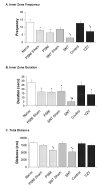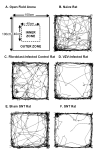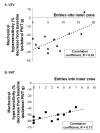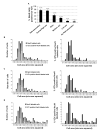Further characterization of a rat model of varicella zoster virus-associated pain: Relationship between mechanical hypersensitivity and anxiety-related behavior, and the influence of analgesic drugs
- PMID: 17197105
- PMCID: PMC2394505
- DOI: 10.1016/j.neuroscience.2006.11.029
Further characterization of a rat model of varicella zoster virus-associated pain: Relationship between mechanical hypersensitivity and anxiety-related behavior, and the influence of analgesic drugs
Abstract
Persistent herpes zoster-associated pain is a significant clinical problem and an area of largely unmet therapeutic need. Progress in elucidating the underlying pathophysiology of zoster-associated pain and related co-morbidity behavior, in addition to appropriately targeted drug development has been hindered by the lack of an appropriate animal model. This study further characterizes a recently developed rat model of zoster-associated hypersensitivity and investigates (a) response to different viral strains; (b) relationship between viral inoculum concentration ('dose') and mechanical hypersensitivity ('response'); (c) attenuation of virus-associated mechanical hypersensitivity by clinically useful analgesic drugs; and (d) measurement of pain co-morbidity (anxiety-like behavior) and pharmacological intervention in the open field paradigm (in parallel with models of traumatic peripheral nerve injury). Varicella zoster virus was propagated on fibroblast cells before s.c. injection into the glabrous footpad of the left hind limb of adult male Wistar rats. Control animals received injection of uninfected fibroblast cells. Hind-limb reflex withdrawal thresholds to mechanical, noxious thermal and cooling stimuli were recorded at specified intervals post-infection. Infection with all viral strains was associated with a dose-dependent mechanical hypersensitivity but not a thermal or cool hypersensitivity. Systemic treatment with i.p. morphine (2.5 mg/kg), amitriptyline (10 mg/kg), gabapentin (30 mg/kg), (S)-(+)-ibuprofen (20 mg/kg) and the cannabinoid WIN55,212-2 (2 mg/kg) but not the antiviral, acyclovir (50 mg/kg), was associated with a reversal of mechanical paw withdrawal thresholds. In the open field paradigm, virus-infected and nerve-injured animals demonstrated an anxiety-like pattern of ambulation (reduced entry into the central area of the open arena) which was positively correlated with mechanical hypersensitivity. This may reflect pain-related co-morbidity. Further, anxiety-like behavior was attenuated by acute i.p. administration of gabapentin (30 mg/kg) in nerve-injured, but not virus-infected animals. This model will prove useful in elucidating the pathophysiology of zoster-associated pain and provide a tool for pre-clinical screening of analgesic drugs.
Figures










References
-
- Abendroth A, Arvin AM. Immune evasion as a pathogenic mechanism of varicella zoster virus. Semin Immunol. 2001;13:27–39. - PubMed
-
- Back SK, Won SY, Hong SK, Na HS. Gabapentin relieves mechanical, warm and cold allodynia in a rat model of peripheral neuropathy. Neurosci Lett. 2004;368:341–344. - PubMed
-
- Belzung C, Dubreuil D. Naloxone potentiates the anxiolytic but not the amnesic action of chlordiazepoxide in C57BL/6 mice. Behav Pharmacol. 1998;9:691–698. - PubMed
-
- Bonabello A, Galmozzi MR, Canaparo R, Isaia GC, Serpe L, Muntoni E, Zara GP. Dexibuprofen (S+-isomer ibuprofen) reduces gastric damage and improves analgesic and antiinflammatory effects in rodents. Anesth Analg. 2003;97:402–408. - PubMed
Publication types
MeSH terms
Substances
Grants and funding
LinkOut - more resources
Full Text Sources
Other Literature Sources
Medical

